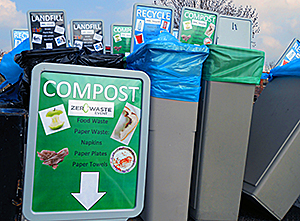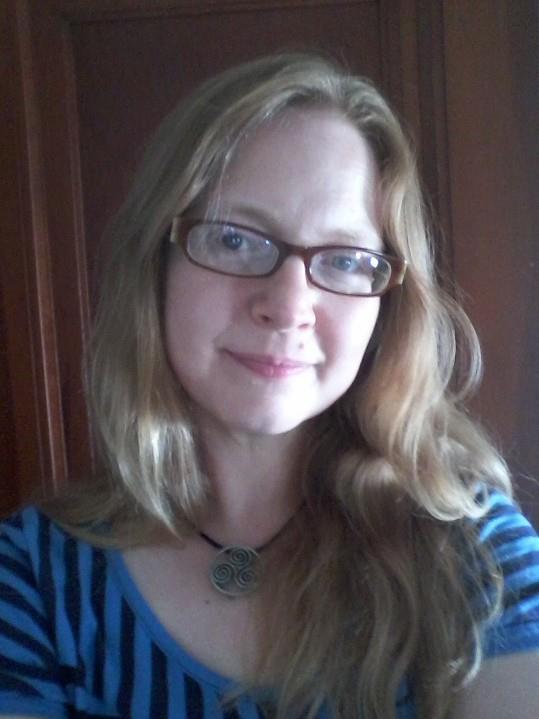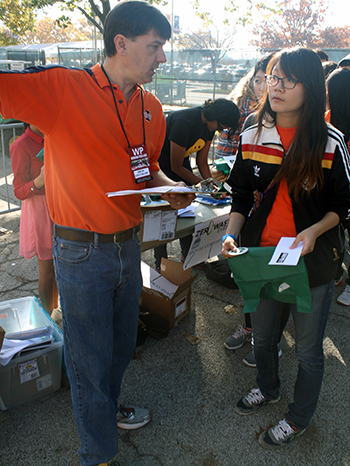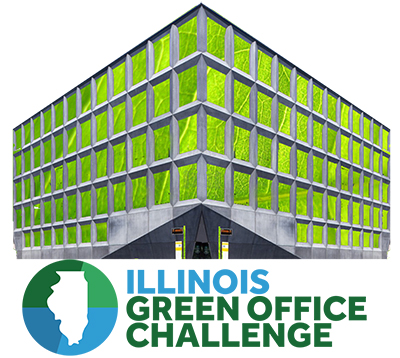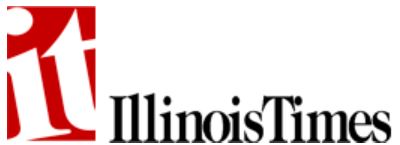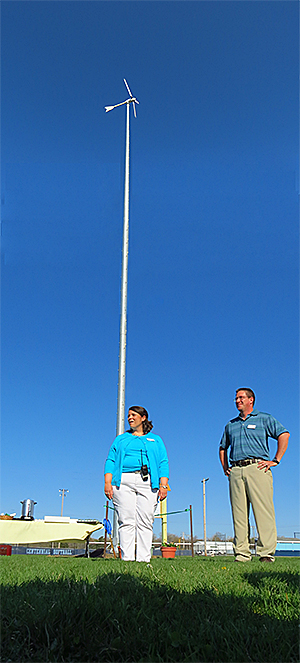International Sustainable Electronics Competition Awards 2013 Winners
Old smart phones don’t have to be doomed to silence in a drawer or a landfill. According to two winners of the 2013 International Sustainable Electronics Competition the phones can keep track of your cattle, or be tiled together to form large-scale electronic displays.
The winning entries were announced in a ceremony on Thursday, Dec. 5, at the Illinois Sustainable Technology Center (ISTC), a division of the Prairie Research Institute, at the University of Illinois at Urbana-Champaign. Nine students on four teams from around the world were awarded prizes for their ideas on the beneficial reuse of electronics to prevent e-waste generation.
The Sustainable Electronics Initiative at ISTC has held the annual competition since 2009 to prompt dialogue about the environmental and social impacts of electronics and to contribute to the body of knowledge that advances the practice of environmentally responsible product design, manufacture, use, and disposal for electronics. The competition is open to college and university students and recent graduates.
The winners in the Product Category (items intended for sale) were:
- E-waste Meets Farming, smart phones remanufactured as cow collars (Platinum, $3,000) Michael Van Dord, Swinburne University of Technology, Melbourne, Australia;
- Mion, a multi-purpose dynamo lighting system (Gold, $2,000) Mikenna Tansley, Jiayi Li, Fren Mah, Russell Davidson, and Kapil Vachhar from the University of Alberta, Canada;
- Cellscreen, a large scale display system made from old phone displays (Silver, $1,000) Sam Johnston, Swinburne University of Technology, Melbourne, Australia.
One platinum level ($3,000) winner was named in the Non-product Category (concepts valuable for artistic, educational, policy, or similar content):
- ENERGENCIA, a children’s’ game encouraging the use of recycled materials and renewable energy concepts by Stephanie Vázquez and Pedro Baños of Instituto Tecnológico y de Estudios Superiores de Monterrey Campus Puebla, Mexico.
“The world must find ways to end the tide of e-waste in the environment,” said Craig Boswell, U of I graduate and president of HOBI International, an ISO 14001 certified electronics recycling and asset management company. “This competition, and these brilliant young winners, help us advance the dialog about environmentally responsible product design, manufacture, use, and disposal of electronics,” he added.
Boswell was one of an expert panel of six judges consisting of industry professionals, recycling experts, and the competition founder, William Bullock, professor of Industrial Design, University of Illinois, Urbana-Champaign. The cash prizes were funded by donations from Arrow Electronics, Professional Field Services and ISTC.
Other jurors were: Jason Linnell, executive director, National Center of Electronics Recycling; Bill Olson, director, Office of Sustainability and Stewardship, Motorola Mobility, LLC; Lynn Rubinstein, executive director, Northeast Recycling Council; and Kyle Wiens, CEO, iFixt and Dozuki.
Joe Verrengia, director of Corporate Social Responsibility for Arrow Electronics, participated in the ceremony, noting “We understand more than ever now that the end of life of all of those electronics is often very short. We need to come up with something better to deal with that. Competitions and incubators can develop those ideas that hopefully help the world, help Arrow, and maybe be a source of really smart new workers in the future.”
The videos of the winning entries are featured on the competition site, ewaste.illinois.edu, the SEI site, sustainelectronics.illinois.edu, and SEI’s You Tube channel, youtube.com/seiatistc.
See below for a more complete description of the winners and their entries.
Product Category
Platinum ($3,000): E-waste Meets Farming. This project tackles e-waste through the reuse of discarded but internally (circuit board and CPU) functioning smart phones in the manufacture of cow collars. A cow collar is a device worn by cattle on dairy farms which can store information about the individual animal wearing it. It can also send that information to a central hub to be backed up, and communicate with machinery on the farm so that the cow is fed correctly and milked for the correct amount of time, etc. Cow collars can warn farmers of sickness or other health concerns for individual animals by monitoring activity and conditions through the inclusion of a GPS and accelerometers. The advantage of reusing smart phones in cow collars is that all the necessary components are assembled in a very compact and highly functional way. The phone has GPS, accelerometers, wireless technology, printed circuit boards, and software compatibility. Furthermore phones damaged beyond the point of being internally functional can also be used for the manufacture of cow collars, by being recycled via normal streams. The resulting materials, such as plastics, can be used in the construction of casing and external collar components. This concept was submitted by undergraduate in product design engineering, Michael Van Dord, from Swinburne University of Technology in Australia.
Gold ($2,000): Mion. Mion is a multi-purpose, dynamo-powered bike light for people living in disadvantaged communities. Their lack of an adequate source of lighting makes it difficult to perform evening tasks, including children’s studies, resulting in a significant barrier to human development. Mion is designed with consideration for the people living in these communities and who are lacking traditional furniture. Its organic form provides multiple lighting angles when placed on a flat surface, one focused and one ambient. This allows for optimal lighting, giving the user an option between more open or focused coverage. Mion uses the energy provided by a dynamo: a small motor that generates electricity using the propulsion of a bicycle wheel. The dynamo uses rotating coils of wire and magnetic fields to convert mechanical rotation into a pulsing direct electric current through Michael Faraday’s law of induction. In the long term, a dynamo is both cheaper and more ecological than a battery-powered system. When Mion is clamped onto the bike frame, it uses a direct energy source from the dynamo, charging its reserve AA batteries while also having the ability to provide light during the evening hours. Its detachable clamp allows the user to bring the lighting fixture wherever needed. In addition, the reserve, rechargeable AA batteries, may be removed and used within other products. These batteries become a significant object in themselves as the lack of reliable electricity can lead to other issues with day-to-day activities. Each part of Mion is made from recycled electronic waste. The internal components of the light and dynamo are repurposed parts from old electronics such as desktop computers, cameras, and cell phones (including LEDs, magnets, copper wire, and gears in the dynamo). Both the housing unit for the light and the dynamo casing are made of recycled plastics which can be reclaimed from electronic devices. Mion was submitted by a group of design students (Mikenna Tansley, Jiayi Li, Fren Mah, Russell Davidson, and Kapil Vachhar) from the University of Alberta in Canada.
Silver ($1,000): Cellscreen. The Cellscreen is a large-scale, coarse display intended to function as an advertisement or public display. The Cellscreen itself can be thought of as a tile which forms the base unit from which many different configurations can be made. Each tile is comprised of disused cell phone displays which form the display matrix. The premise is that a run of tiles can be produced from one set of screens at a time due to the large volume of cell phones that are disposed of. For example, there might be a range of tiles comprised entirely of iPhone 3g screens. Grouping screens by type is intended to circumvent any issues that might arise from display quality when mixing and matching screens from different manufactures and for compatibility. Cellscreen tiles comprised from older devices, such as early color screens, might be well suited to large scale advertising whereas those from newer devices with high pixel density and touch functions might be suited to other applications, such as information kiosks. Cellscreen is targeted toward manufacturers and suppliers of cell phones encouraging them to reclaim their obsolete products for reuse in a new product. Cellscreen was submitted by Sam Johnston, an undergraduate in product design from Swinburne University of Technology in Australia.
Non-Product Category
Platinum ($3,000): ENERGENCIA. ENERGENCIA is a game kit in which children can build their own toys using recyclable materials, reusable electronic devices, and renewable energy concepts to create projects that can move, turn lights on, etc. These projects employ reusable, reclaimed electronic components like small engines supplied in the game kit. The other recyclable materials like cardboard, cans, and plastic bottles can be obtained by children themselves to complete a project. Through the projects made possible by the game kit children learn about alternative energy sources and develop environmental awareness and positive environmental behaviors. The students who submitted this concept developed theories related to the ideal age range of children for which this kit would be effective, and they investigated these ideas through a hands-on workshop for children conducted in cooperation with teachers from schools at the American School of Puebla. This concept was submitted by undergraduates Stephanie Vázquez and Pedro Baños of Instituto Tecnológico y de Estudios Superiores de Monterrey Campus Puebla in Mexico.
